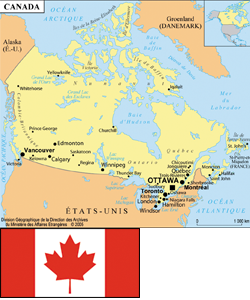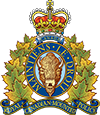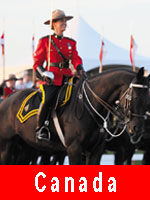 Royal Canadian Mounted Police
Royal Canadian Mounted Police
|
1920 Ministry of attachment: Ministère de la Sécurité publique du Canada Workforce: 28 651 General manager: Commissaire Bob Paulson Address: Immeuble QG - 73 prom. Leikin Tél.: (+1) 613-843-4652 Fax: (+1) 613-993-0260 Website: www.rcmp-grc.gc.ca 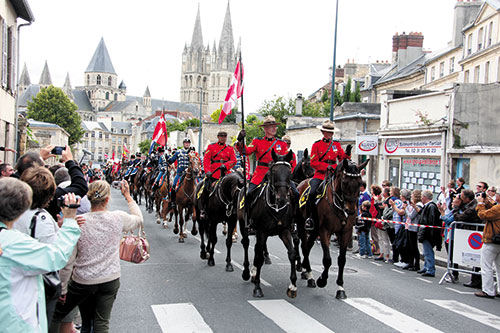
|
History
Originally created to answer the need for a police service in charge of the law implementation in the western territories recently acquired by Canada, the Royal Canadian Mounted Police (RCMP) became over the years a world-famous recognized organization. In May 1873, the Parliament of Canada set up a central police service. A 150 recruits’ group was sent to the West, in the Manitoba.
The new Police corps is baptized "Northwest Mounted Police" (PCN-O). In 1919, the Parliament decides to merge this body with the Dominion police, a federal police service that exercised its authority in the East part of Canada. When the law comes into force, on February 1st, 1920, the new set group takes the double name of Royal Canadian Mounted Police and (CRG). The headquarters is transferred from Regina to Ottawa.
Between 1932 and 1938, the CRG staff double in order to reach 2 350 employees when it begins to provide provincial police services in Alberta, Manitoba, New Brunswick, Nova Scotia and in the Prince Edward Island. During the Second World War, CRG’s members perform provost ships/military polices missions with the Canadian army. After 1945, the CRG enjoys a new expansion as provincial police service.
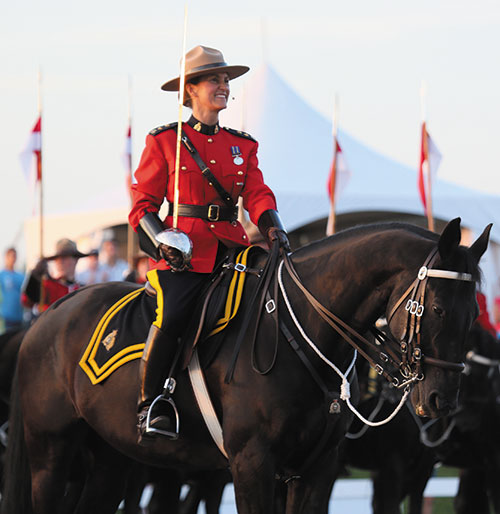
In 1950, it assumes responsibility for the police service in Newfoundland and annexes the British Columbia provincial police service. Feminine gendarmes enter for the first time the CRG ranks in 1974. It is also during the 70s that CRG responsibilities are extended in new domains, as the airport police services, the protection of high profile personalities or persons and the fight against drugs.
Today, the CRG/RCMP’s scope of operations includes: combating organized crime, terrorism, drug trafficking, financial crimes and offences that threaten the integrity of Canadian national borders. Furthermore, it delivers police services in eight provinces and three territories and, by the intervention of its Police National Service, puts resources available to other law enforcement Canadian bodies.
Organization
The Royal Canadian Mounted Police (RCMP) is established under the regime of the Law on the Canadian Royal Gendarmerie (CRG). The CRG applies everywhere to the country the laws elaborate and adopted by the Parliament. The administration of the justice in provinces, including application of the criminal Code, is a part of powers and of responsibilities delegated to the provincial governments. RCMP provides police services to the municipality under contract in all the provinces (except Quebec and Ontario), in the Yukon, Northwest Territories and in Nunavut, by virtue of different agreements, in 180 municipalities.
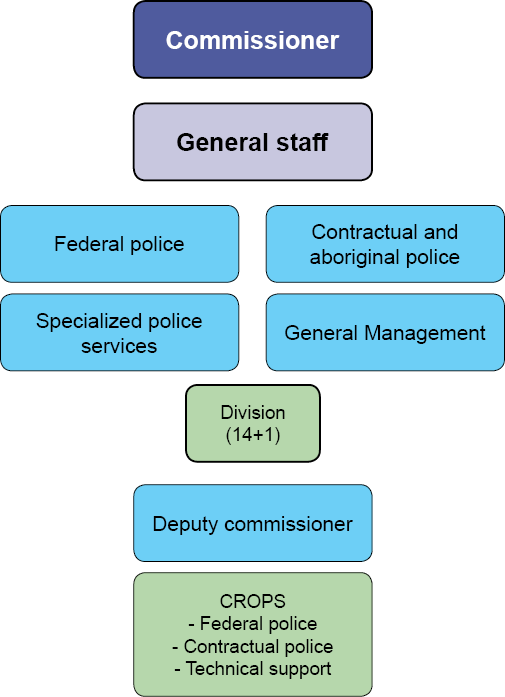
Central Organization
The General Headquarters (GHQ) is the centre of decision created by the CRG for the elaboration and the approval of the gendarmerie general strategic policies, by virtue of the powers, which confers it, the article 5 of the Law on the GRC. The GHQ has for role to develop, to promote and to communicate the objectives and the strategic priorities, management strategies and performance management for the purpose of direction and accountability. The Police commissioner is assisted by:
• the Federal Police Assistant-Commissioner (federal and international operations, criminal investigations related to the National Security, the protection police);
• the Assistant-Commissioner in charge of Contract and Aboriginal Police Services;
• the specialized Police services Assistant-Commissioner (Firearms Canadian program, Canadian police information centre, national centre of coordination against the children’s exploitation, Police Canadian college, judicial sciences and identity department, the Criminal intelligence Canadian department);
• the Chief audit executive, internal audits and program evaluations/examinations;
• the Chief human resource officer;
• the Finances and Administration Assistant-commissioner;
• the Strategic policies and planning Chief audit executive;
• the Assistant-commissioner for public affairs.
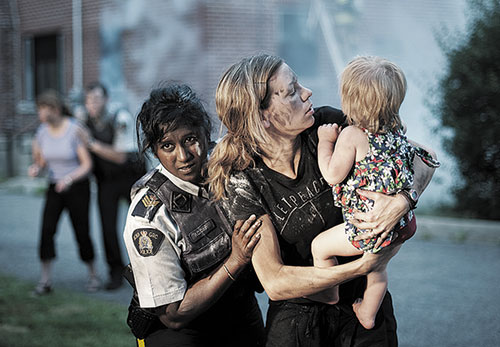
Territorial organization
• 15 divisions. This naming reminds its military past. Every division covers more or less the borders of every Canadian province or territory. Each of those Gendarmerie 15 divisions is head up by a commander (generally a Deputy-commissioner) and is indicated by a letter of the alphabet. Ontario, however, contains two divisions: One for the Ottawa national capital and another one for the rest of the province. The fifteenth division, called “Warehouse”, is in charge of Regina (Saskatchewan) training school and the Bowden Dog police training centre (Alberta).
- Division B: Newfoundland and Labrador.
- Division C: Quebec.
- Division D: Manitoba.
- Warehouse Division: Regina, Saskatchewan.
- Division E: British Columbia.
- Division F: Saskatchewan.
- Division G: territory of the northwest.
- Division H: Nova Scotia.
- Division J: New Brunswick.
- Division K: Alberta.
- Division L: Prince Edward Island.
- Division M: Yukon Territory.
- Division O: Ontario.
- Division V: Nunavut.
- National Capital Region National Division.
Specialized Training
• Scientific Police (toxicology, chemistry, biology - DNA tests and Law).
• Technical Police (fingerprint, instrumentation, documentation, forgery, firearm, electronics, computing, communications and telecommunications).
Missions
In its non-contractual role, the RCMP possesses several federal mandates, of which Interpol in Canada, various antiterrorist sections, Canadian Prime Minister’s protection, protection of the Canadian Secretaries and foreign dignitaries on visit, Organized Crime investigations and intelligence sections, protection of the Canadian embassies abroad, Canadian youth crime prevention, Indian reserves (Amerindian) police, and the maintain the Canadian firearms registry located in the in the city of Miramichi (New Brunswick). Some of these mandates are also implemented in eight contractual provinces and the three territories.
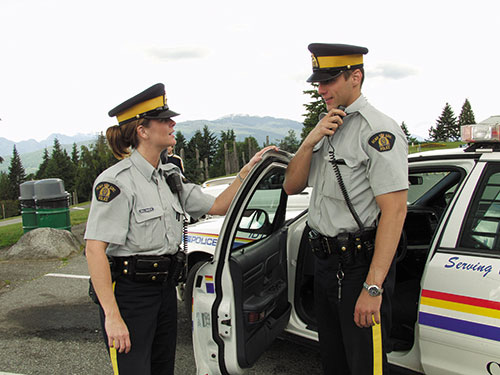
In its contractual mandate, in three territories (Northwest Territories, Yukon and Nunavut) and in eight provinces (Nova Scotia, Prince Edward Island, New Brunswick, Newfoundland, Manitoba, Saskatchewan, Alberta and British Columbia), it maintains gendarmerie local posts of gendarmerie where the gendarmes deal as well with the Traffic rules as the criminal investigations. We find specialized centres in scientific police, counter-narcotics, etc. At this level, the RCMP maintains narrow links with the municipal and provincial police services.
A special team, called the "RCMP Carousel", travels through Canada and offers an equestrian show, recalling the first moments of its history. This Merry-go-round "RCMP Carousel" gives of admirable representations in several countries, among which the United States and France.
Staff
The lower ranks of the RCMP/CRG policemen have for origin those of the 19th century Canadian army who were almost identical to those of the current British army. The superior ranks are rather inspired by the civil administration and increased in number or in importance with time, as the police strength increased its staff. For example, the rank of Inspector was initially the one of a junior officer but it became that of a senior officer. The Inspectors and other senior officers are appointed in council by the governor general (Canadian Council of Ministers). The non-commissioned officers and the gendarmes form the majority of the staff in the regional posts and their promotion is made by competitions. The ranks are worn on the dress uniform sleeve but in shoulder strap on the gendarmes’ working jacket or shirt. Besides the regular policemen, we count special gendarmes, auxiliary gendarmes, civil members and state employees or students. Those people are wearing distinctive badges of those of the regular policemen. The rank of lance corporal, which was represented by a single chevron, does not exist any more since the end of the Second World War. The civil members do not have "peace officers" powers and are hired for their expertise. We find them in:
• the scientific police (toxicology, chemistry, biology – DNA tests and law);
• the technical police (fingerprint, instrumentation, documentation, forgery, firearm, electronics, computing, communications and telecommunications);
• the administration (public relation, administration, human resources, translation and police ethics).
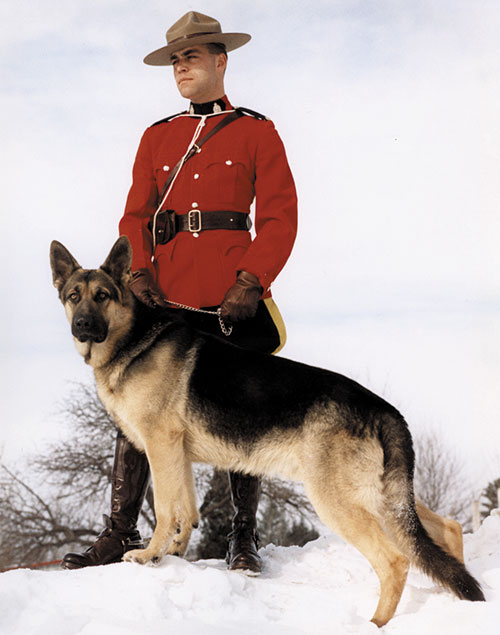
Training institutions
Established in 1885, the Saskatchewan Regina’s Training centre depends on the RCMP’s "Warehouse" division. To become a gendarme of the RCMP, it is necessary to satisfy the following basic requirements: To be Canadian citizen, to speak fluently the one of both Canadian official languages, to be a holder of a Canadian secondary education diploma or the equivalent, to possess a valid Canadian driving licence and without any limitation, to be 19 years old at the time of the commitment. The candidates for the RCMP are informed that they are investigated and have, then, to cross a battery of personality and physical tests in order to estimate their capacities in touch with the work of policeman. Once accepted for the training, they are sent in the Regina’s training centre (Saskatchewan). The selected candidate follows the Cadet training program of a 24 weeks duration.
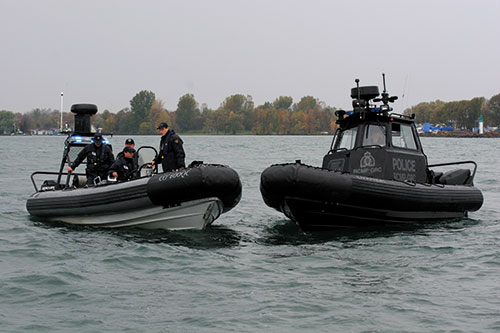
Main equipment
• Armament: Since the 1990s, Sig-Sauer P226 and P220, S&W 5946 and 3953, Diemaco C7 and C8, Remington 870, pistol with electric impulse and Model 70 Winchester.
• Vehicles: Ford Crown Victoria, Chevrolet Impala, Chevrolet Lumina, Chevrolet Caprice, Chevrolet Camaro, Chevrolet Cube Van, Chevrolet Suburban, some SUV Land Rover models, Ford Mustang, Ford Expedition, Ford Explorer, Ford Cube Van, Ford Command Post, GMC Jimmy, GMC Van, GMC Yukon, GMC whim, Volkswagen Beatle and PT Cruiser. Harley Davidson motorcycles.
• Nautical means: Patrol boats, catamaran and speedboats.
• Aerials means: Helicopters (Bell 206, Eurocopter AS 350B3s) - Had (Piaggio P180 Avanti, Cessna Caravan, Cessna, Twin Otter and Pilatus PC 12),
Cooperation
In 1989, Commissioner Norman Inkster agrees to send civil policemen to watch over and monitor the respect for the law and order during the first democratic elections organized in Namibia (South West Africa). A contingent of 100 members under the superintendent Pr. Larry R. Probe’s command stays in Namibia between October 19th, 1989 and April 11th, 1990 in order to watch the South West Africa Police and to provide a presence in polling stations. It was the first time that the RCMP/CRG participated in a UNO mission (GANUPT). Since this date, more than RCMP/CRG participated in about 60 peace operations within 30 countries. Today, approximately 90 policemen are deployed in peace operations in the West Bank and in Haiti. There are, among this number, two senior advisers, one attached to the United Nations Canadian Permanent Mission in New York; the other who is attached to the team of the Permanent Police Force of the United Nations Permanent Police Force in Brindisi (Italy).
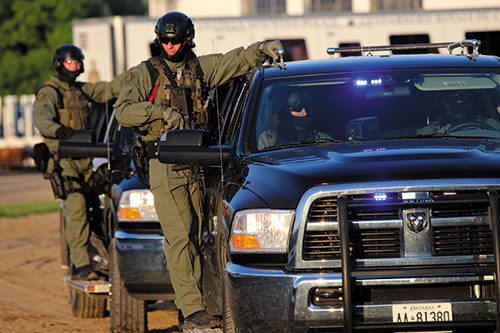
© The iconography was provided by the concerned gendarmeries

